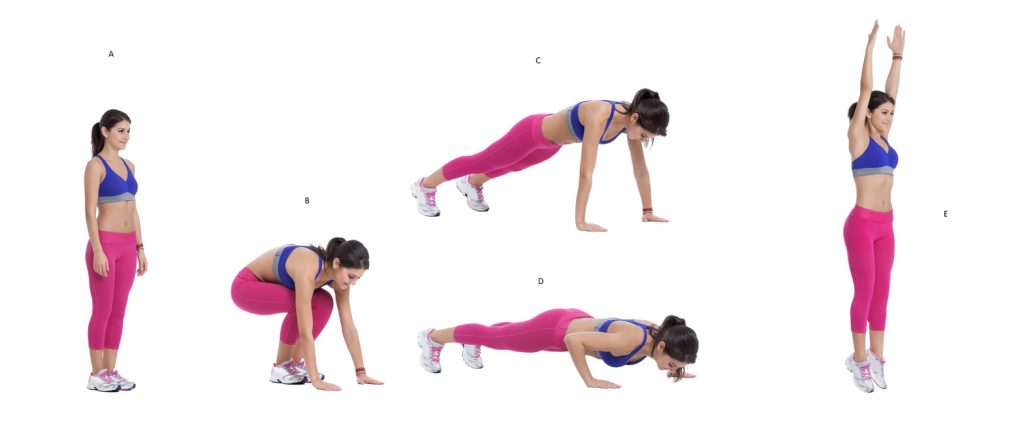The Burpees
When we start doing sport or physical activities, we are not always aware of all the techniques and movements that can help us achieve our goals. Faced with this, it is sometimes important to get informed, especially if you are a beginner. For beginners, here is a guide to Burpees, a plyometric exercise, which will help improve fitness.
Burpees, what does it do?
Before we know what the burpee does, we must first define what it is. The burpee is a strength and aerobic exercise that involves the whole body. It is named after the American physiologist Royal H. Burpee, who developed it as part of his applied physiology thesis, defended in 1940 at Columbia University.
Originally, the exercise consists of a sequence to be repeated in a loop: a squat with hands on the ground, followed by a throw of the feet backwards to arrive in a plank position, while keeping the arms stretched. You then have to return to the squat position before finally standing up.
Over the years, many variations have been incorporated into the loop. The most common are a jump on the last step or a pump at the plank position.
The burpee is a functional exercise because it mobilises many muscles in a coordinated manner during its execution. Among the muscles most used are:
- Triceps
- Front of the shoulder
- pectoralis major
- trapezius and all shoulder blade fixators
- abdominal strap
- hip flexors
- thighs, glutes, ischios and calves.
The dynamic execution of burpees requires a significant effort of sheathing/fixation, which adds difficulty to its realization.
The "chain" work of the burpees is similar to everyday actions: bending down, getting down, getting up, jumping. The burpee is widely used in the military, but also in obstacle races such as the Reebok Spartan Race.
What are burpees used for?
Burpees are often considered a"calorie killer"because it requires a substantial effort for the body.
For athletes worthy of the name, there are many interests in performing this movement in workouts.
- To improve physical condition {1): performed in long series, burpees strongly solicit the aerobic system;
- To improve anaerobic resistance, as shown in the study by Saka maki (2);
- To increase the cardiac and energetic demand of a sequence: by adding them to a set of exercises to make them more "cardio";
- To improve ease of movement at body weight: doing a burpee requires mobility, coordination, and body awareness;
- To challenge yourself: for example, challenge yourself to do 50 burpees (or more) as fast as possible;
- To make a group of athletes work easily;
- To "punish" an athlete who does not respect the rules.
The Burpee test
The Burpee Test is a measure of physical fitness. This test evaluates physical performance according to the maximum number of burpees performed, without time limit and without breaks.
| Maximum number of burpees | Fitness level |
| 0 to 31 | Bad |
| 31 to 41 | Normal |
| 41 to 51 | Good |
| Over 61 | Excellent |
Variants
To vary the pleasures and challenge yourself, there are several ways to spice up the burpees:
- Burpees with a weighted vest
- Burpees with a jump over a barbell
- Burpees with a jump over a box
- Burpees with knee raise during the jump
- Burpees with a pull-up jump
- ½ burpees: do not do push-ups, do not jump. With a standing start, put your hands on the floor, throw both legs back, bring to chest and stand up
- Pistol Burpees: instead of jumping with both legs, once in a group position (knees towards the chest), take support on 1 foot (pistol squat) and stand up with the strength of one leg
- Burpees with backward/forward salto: instead of jumping up, the idea is to perform a backward or forward salto.
In short, burpees are a great way to burn calories and improve fitness! A must to include in your training!
References
(/): McRae, G. , Payne, A. , Zelt, J. G. E. , Scribbans, T. D. ,Jung, M. E. , Little, J. P & Gurd, B. J. (2012), Extremely low volume, whole-body aerobic-resistance training improves aerobic fitness and muscular endurance in females. App/ied Physiology, Nutrition & Metabolism, 37(6), 1124-1131
(2) : Sakamaki, T. (1983). A study of the burpee push up test as simple method of measuring endurance. Nippon lka Daigaku Zasshi/Journal Of The NipponMedical School, 50(2), 173-190.



